A raw diet for cats can be a very healthy alternative for your pet.
I have been researching on this subject and have seen a lot of benefits of feeding whole food based diets.
However, before moving to a raw diet, cat owners should consider the potential risks involved.
What food is healthy for your pet cat? Is it really safe to feed cats with fresh food diets? Can my cat get seriously ill after eating uncooked food?
These are some of the questions every pet owner asks at least once in their lifetime.
So, it is necessary to consume uncooked animal products in order to follow a nutritious diet, rather than the conventional dried or canned foods.
Choosing cat food can be a difficult chore, especially when we have to keep in mind the possibility of commercial pet food recalls at all times.
While cooking for your pet feline at home, you need to exactly know what ingredients are being used in the preparation.
The diets prepared at home might be either cooked or uncooked in nature.
Most pet owners like you may want to offer your cat a diet that is comparable to what they may eat in the wild. This is becoming increasingly popular.
But, what’s best for your feline companion? Continue reading and you will discover everything!
What Exactly Is a Raw Diet for Cats?
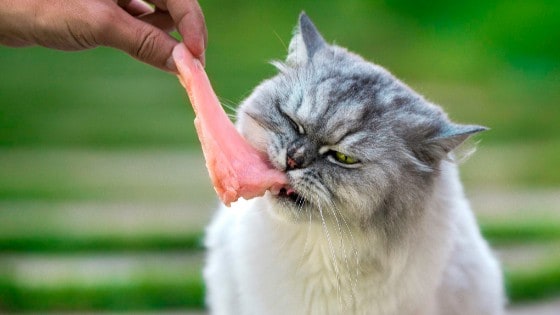
When we say "raw," we might refer to a wide variety of items of raw food samples, including frozen foods, dry foods, wet foods, homemade food, and dehydrated alternatives.
Raw diets generally have a high animal protein content (typically muscle meat), organs, bones, as well as a soluble fiber source, all of which contribute to the overall nutritional profile of the diet.
In order to be considered really "raw," the food must not have been cooked in any way before consumption.
A raw diet for cats consists of feeding them uncooked animal products that have not been processed in any manner.
This category includes all sorts of meat, including muscle meat, organ meat, ground bone, and raw bones, among others.
It is known as the "BARF" diet, which stands for "bones and raw food" or "biologically-appropriate raw food," based upon who you speak with.
The best raw diet for cats is made by following a recipe that has been meticulously tested and refined over time.
Cat owners like you may prefer to cook food at home for your companion, although there are commercially produced food products that you can purchase if you so desire.
Any raw diet that you want to feed your cat should be evaluated by a veterinary nutritionist to ensure that it is complete and balanced before it is given to your cat to consume.
The consumption of an imbalanced diet by cats increases the likelihood that they may acquire a variety of health problems.
Why Consider Raw Food for Your Cat?
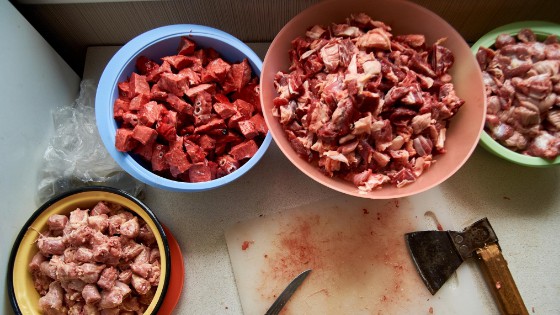
Felines are carnivores, which means they must consume meat in order to thrive.
Contrary to popular opinion, cats do not require vegetables or carbohydrates as part of their daily diet.
Carbohydrates, on the other hand, are only required in small quantities at any given time.
Cats like diets that are high in protein and moisture content, and are particularly nutrient-dense in chemicals that are only found in animal products.
Taurine and fatty acids, among other essential amino acids and nutrients, are found in this supplement, as are other vitamins and minerals necessary by the body.
According to an expert veterinarian, cooking meat may alter or diminish the amount of these critical elements present in the meat.
He argues for a physiologically appropriate diet that closely personifies what a cat would intake in the wild, rather than a more conventional diet at home.
Mice and other small animals such as birds, fish, insects, and even reptiles are preyed upon and devoured by small wild cats.
When it comes to feeding your own cat with raw food diet, it's kind of equivalent to the diet of a wild cat.
There is a lot of controversy around raw food diets for cats and dogs and other pet animals.
Raw food cat supporters have a lot to say about the health benefits of these diets, including how the coats of their pets have become brighter, their teeth remained cleaner, obesity avoided, and how their overall health improved.
Despite the fact that these assertions are substantiated by scientific evidences, the real concerns lies in the safety of raw cat food diets.
Is It Safe To Use Raw Food Diets?
It is critical to understand that feeding raw food to your cat can result in serious health consequences.
Foods that are served raw may include germs such as Salmonella and E. coli, which can cause serious and life-threatening infections in felines who are vulnerable to them.
We humans prefer to cook our meals as it kills the vast majority of germs present in the raw food.
On the other hand, cats have shorter and more acidic digestive systems than humans, and hence they are typically better at digesting raw foods than humans.
It's seen that a significant proportion of infections will easily pass through a cat's system without causing any issues.
However, certain cats (particularly those with immune-mediated diseases) may require hot food in case they have any health concerns.
One of the most important dangers linked with consuming and handling raw meat is the likelihood of cross-contamination with other foods.
Providing your cat with a raw food diet may expose you and other members of your household to bacteria that are possibly hazardous.
Pathogens can remain on surfaces such as cooking surfaces, food plates, cat fecal matter, and even on your cat's fur in some situations (especially around the face).
Cats that reside in homes with people who have immune system diseases should not be fed a raw diet, as per the American Veterinary Medical Association.
According to experts, families with young children and/or elderly people should refrain from utilizing them.
There are various precautions you can take to ensure that your cat's raw food diet is as safe as possible, even though it is impossible to totally eliminate all risks.
- Prepare the food in a well-ventilated section of the house; thereafter, properly clean and sterilize the area (use a 1:32 bleach to water solution if possible)
- Wear gloves while preparing raw meat
- Use frozen food
- Make use of meat ingredients sourced from a reputable store
- Feed your cat in a place that is easy to clean afterward (no carpeting or upholstery nearby)
- Food bowls should be disinfected promptly after use (scrub clean, then use a 1:32 bleach to water solution, then rinse and dry bowls)
When it comes to raw food diets, bones are another source, however if proper precautions are not taken, it may lead to a variety of problems including gastrointestinal blockages, oral injuries, and breathing obstructions.
If you are including animal bones in your cat's raw food diet, be absolutely certain they are completely broken before serving them.
Complete and Balanced Raw Food Diet For Cats
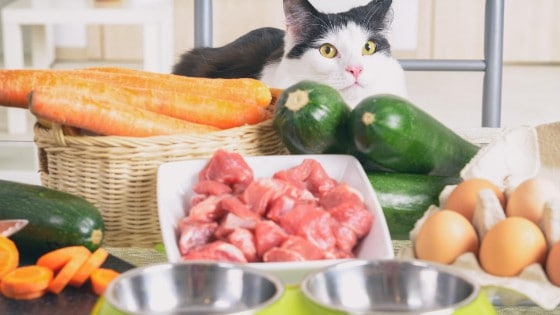
While preparing raw diet for your cat, you must ensure that it is well balanced and nutritional.
Some owners simply feed their cats with "all meat and bones" without taking into considering the calorie, fat, protein, and vitamin levels in the food.
Simply giving your cat "as much meat as it requests" would not give him all of the nutrients he requires to maintain his or her best health.
Providing your cat with minimal food over an extended period of time can result in serious health problems.
Wild cats and stray dogs may be able to survive on random raw meat, which may encourage you to feel that this is a good nutritious choice. However, it is important to remember that wild animals have lower life spans than domesticated pets.
A significant portion of this can be ascribed to dietary factors.
It is vital to follow a recipe that has been certified by a veterinarian and is both filling and nutritionally balanced.
Communicate with your veterinarian about recipes that provide complete and balanced nutrition for your cat's unique nutritional requirements while designing a raw diet for him.
You should be aware that many veterinarians will not recommend raw meals because of the risks associated with it.
You should explore finding a doctor that has past experience with raw foods if you are seriously considering experimenting with them but your veterinarian is unable to be flexible. Even better, find a veterinary dietitian who has experience with raw meals and can consult with you on your options.
How to Prepare a Raw Diet for Your Cat?
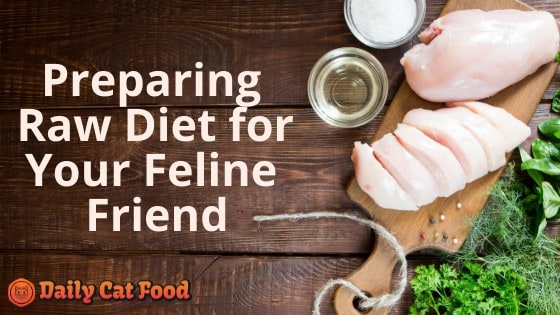
There's always an advantage to consult your veterinarian while you are creating a healthy and nutritional diet for your cat.
An additional supplement by your vet can ensure that your pet cat gets the essential nutrients he or she require to be kept healthy.
The following are examples of ingredients that may be utilised while making a raw cat food diet:
- Muscles and organs that are used to make raw meat (good sources include poultry, rabbit, and fish)
- Bones in their natural state
- Eggs
- Supplement Food
In order to create the raw diet, you will most likely require the following equipment and materials:
- A big cutting board that can be washed in the dishwasher
- Meat grinders to mince meat
- Poultry shears
- Mixing bowls made of stainless steel or glass
- Gloves that are disposable (latex or nitrile)
- Containers for storing items
- Space for a freezer and a refrigerator
Raw diet preparation takes time at home, hence you may produce enough food to last several days that can be kept it in the freezer.
Commercial Raw Diets for Pet Cats
If you are unable to devote time for preparing recipes and raw cat food at home, you may consider buying the available commercial raw diets in the market.
Raw diet adherents frequently believe that commercial raw diets are inferior to those cooked in the home. In contrast to kibble, they are regarded to be healthier to consume.
The majority of commercial raw diets are frozen or freezer-dried in order to curtail the presence of germs. It's important to follow all safety precautions as these dits may get contaminated.
Check with your veterinarian or pet dietitian for assistance in identifying the most appropriate commercial feed.
Check to see if it is done accurately and adequate in accordance with AAFCO guidelines.
Other Options For Raw Diet
Consider preparing your own cat food, in order to curb the risks associated with raw cat food while providing a nutritious diet to your cat. You may need to come up with a recipe that is thorough and well-balanced.
Another suggestion is on preparing a high-protein wet cat food with high-quality ingredients.
Many veterinarians and cat nutrition experts agree that dry kibble contains far too many carbs to be considered ideal for cats as many wet foods are manufactured with little or no carbohydrate content.
By reducing or eliminating carbohydrates from your cat's diet extends his or her life expectancy by many years.
An additional benefit of a low-carbohydrate diet for cats is that it can help them avoid health concerns such as obesity and diabetes.
Should You Feed Your Cat A Raw Diet?
In recent years, raw feeding for cats and dogs has gained popularity.
Cats, which are obviously carnivores, can benefit greatly from a raw diet that is comprehensive, balanced, and properly prepared.
Hence, raw diet is a very good feeding option.
Are There Any Advantages Of A Raw Food Diet For Your Pet Cat?
Raw food is beneficial for your cat's dental health and will encourage them to drink more water.
Furthermore, as the food is not heated or cooked, it provides the required protein and has comparatively lower fat levels, thereby avoiding obesity and liver issues.
There are a plethora of raw diets available for purchase in the market today.
Also, if you have time and the necessary education, you can easily prepare raw diet for your cat at home.
What Is The Safety Standard Of Raw Pet Food?
A number of bacterial pathogens pose threat to your cat that consume raw food.
Despite the fact, that your cat have shorter gastrointestinal system, the possibility for cross-contamination is quite high.
Furthermore, these dangerous bacteria tend to have a negative impact on the health of your cat.
There must be strict adherence to food safety rules as well as an extensive cleaning process implemented.
You may use High-Pressure Processing (HPP), which is a food safety technique relying on pressure rather than just heat to assure safety of proteins and nutrition.
This popular technique is frequently used in the commercial sector to ensure safe nutrition.
In order to give the best care for your cat, always follow the raw feeding instructions as well as food storage recommendations.
What Health Problems Are Reduced By Raw Diet For Cats?
As the cats evolved in a desert environment, hence they do not have a high thirst drive like humans.
As raw meat diet tend to include more moisture than cooked diets, they give more hydration, which can help to mitigate urinary problems while boosting overall health of your cat.
Another relieve that comes from following a raw cat food diet is kidney disease which is probably the most common owing to the harmful bacteria.
When the kidneys are in good health, they are capable of performing miracles in terms of activating protein and removing waste from the body.
Due to the alteration in the amino acid makeup of the meal, it has a lower protein efficiency among pets and produces waste that must be worked on by the kidneys after ingestion.
As raw meat diets are low in heat deterioration, it is beneficial in maintaining kidney health.
Why You Should Not Use A Pet Raw Diet?
Raw feeding raises nutritional issues, particularly for pet owners who are unable to provide home-cooked meals that are adequate and healthy for their pets.
The Centers for Disease Control and Prevention or CDC recommends that feeding raw foods to pets should be avoided because of the risks to the animal and any humans who live with them.
Is The Raw Food Diet Complete & Balanced For Cats?
Pet parents like you who are familiar with the nutritional labels on pet food products have definitely come across the phrase "complete and balanced diet".
This term indicates that a food item meets the nutrient inclusion requirements for a specific animal's overall life stage, as determined by the American Animal Feed Control Organization (AAFCO).
Hence, it is necessary to utilize vitamins or nutritional supplements in order to establish a nutritional profile that is comprehensive and well-balanced.
How To Make A Raw Cat Food Diet At Home?
So, while the idea of raw feeding may conjure up visions of putting a piece of uncooked meat into your cat's food dish or human food, the process of making thorough and balanced homemade raw meat diets is not as simple as it sounds.
Raw feeding pose serious threats to the people who are living in the same vicinity.
In order to ensure complete food safety, proper food storage and efficient food cleaning procedures should be followed at all times.
It is normally advised that you consult with an animal nutritionist in order to develop a proper diet for your cat that includes protein from uncooked meats or fish, soluble fiber, amino acids, essential nutrients, as well as proper hydration, among other things.
How Can I Have My Pet Cat Eat A Raw Diet?
Pet cats are well-known fussy eaters in terms of their food eating habits.
You must ensure that your cat receives the least amount of processed nutrition possible.
The most successful technique is typically to gradually limit the amount of processed meals consumed over a period of several months to a year.
A raw food diet can be achieved by gradually including more raw foods such as raw bones and raw chicken into one's diet, with the goal of finally consuming only raw foods.
Should I Use Dry Food & Canned Food For My Cat?
The advantages of feeding your pet cat raw food, as previously stated, is not always achieved by feeding your cat a processed diet.
Cat parents, on the other hand, may be discouraged from having a major changeover to a raw food because of the difficulties in providing a safe, full, and balanced diet with feline nutrition and proteins.
Whenever it comes to giving your cat healthy food, a balance must be made between convenience and nutritious nourishment, just as it is with our own meals.
Can I Use Raw Diet Alternatives?
Although there is no ideal and effective alternative for feeding your cat a totally raw diet, the finest diet possible can be delivered in a number of ways to achieve success.
Freeze food, dry food, and dehydrated diets are two terms that are sometimes used to refer to raw diets in general.
Aiming to avoid heavily heat-processed food products and materials or to accomplish the least amount of heat-damaged nutrients as feasible is the goal of this method of feeding.
What Do The Experts Recommend About Raw Diets For Cats?
Many well-known experts believe that an all-raw food diet may be even more vital for cats than it is for animals such as dogs since cats are stricter carnivores than dogs.
A raw food diet can aid in weight management and a variety of health issues.
While weight gain is always a possibility with uncooked cat food, it is significantly less likely than with cooked foods.
This is particularly noteworthy given the high prevalence of kidney issues and weight gain among cats nowadays.
Final Thoughts
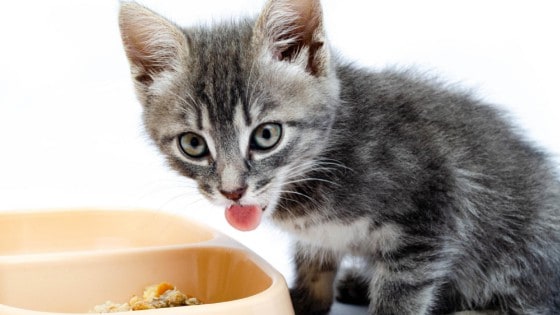
In short, you can serve raw cat food diets to your cat but in a moderate way.
While there are a number of regular food items you can feed your pet cat, there are also some items that you should avoid giving them.
Take into account that your cat’s overall health depends on what you are feeding it and its complete diet.
So, before you make any decision about your cat’s next regular food item, keep all these tips and recommendations in mind and make an informed decision.

